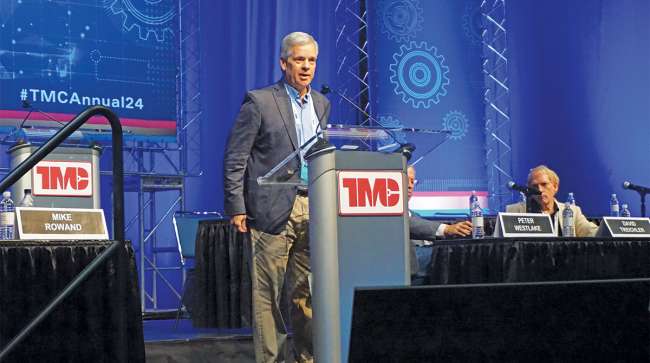Features Editor
The Right Utility Provider Is Key for Fleet Electrification

[Stay on top of transportation news: Get TTNews in your inbox.]
As electrification becomes more of a viable option for trucking businesses, some fleets have found it challenging to find the right utility provider to power their operations. However, to understand the best fit for a commercial fleet, it is important to know the types of providers that are available and understand how they operate.
During American Trucking Associations’ Technology & Maintenance Council Annual Meeting last spring, Mike Rowand, senior adviser for the Electric Power Research Institute, led a panel with energy providers to discuss those differences.
First, he explained the importance of the electric energy grid and how it could benefit a company that is looking to move to electric. Rowand broke down the grid into three areas: generation, transmission and distribution. The generation area consists of the power stations and transformers that send power to the substation in the transmission area. The power is then moved from the substations to the distribution/control equipment that is sent to the end user who is either a commercial and industrial user or residential customer.
Rowand said that there are several considerations fleets face when connecting to the electric grid, breaking that down into three areas: power, energy and time.
“Power is typically a fixed cost, while energy is a variable cost,” he said, adding that power is determined by equipment size and a fleet’s fuel requirements decide their energy needs. The time considerations would involve when and how the power and energy are needed.
Utility providers in the United States fall under three categories: investor-owned, electric cooperatives and municipal power. Each category has its own characteristics.
For instance, a provider such as Entergy, an investor-owned utility, is a publicly traded company that’s governed by a board of directors elected by shareholders. It is also a for-profit corporation, and its rates and services are regulated by its state’s public utility commissions.

Barrios
Scott Barrios, manager of eMobility solutions at Entergy, said at the panel that fleets should seek out other fleets to look at how electrification and alternative fuels are faring in their line of business.
“A lot of industries are looking to find how do we meet that energy demand,” he said. “We have the responsibility to provide reliable and affordable energy.”
Barrios said that it’s best for energy providers to work with fleets for the best work design.
“What can we provide is information to customers on what is needed for electrifying their fleet,” he said.
Jim Musilek, vice president of innovation and business development and strategic management of NC Electric Cooperatives, explained at the panel that the electric cooperative energy provider is community-based, and services primarily rural and suburban areas, democratically controlled and not-for-profit.
“We own the generation and transmission of energy. We are in business to serve our members because they are the customers,” he said. “We are not regulated by the state. We are controlled by a board of directors, and they are controlled by the population they serve.”
The third type, municipal power utilities such as the Orlando Utilities Commission (OUC), are able to quickly implement local policies that support fleet electrification, such as installing municipal charging stations as well as offering incentives to its customers.

Westlake
Pete Westlake, manager of strategic customer programs, finance and contracts for OUC, noted at the panel that no matter what happens in the electrification future, the industry as a whole is most likely five years away from long-range electrification. He also suggested that there needs to be time for the residential, last-mile segments that have used electric energy to resolve their own unique issues before the source is able to grow scale.
However, Westlake did not sugarcoat the complicated process of preparing for fleet electrification that may include construction site designs and planning that could take a significant amount of time.
“It’s a game of 3D chess with Klingon words,” Westlake described.
Barrios stressed the importance of getting everyone in the electrification process.
“We have to learn to speak with each other’s languages,” he said. “That means educating our engineers, customers and billing team. The goal is how do we make it easier for (the fleets). Communication, early and often.”
Kevin Hernandez, partner with consulting firm ScottMadden, told Transport Topics that utilities as well as regulators are taking a variety of approaches to engage with fleet operators as they explore electrifying their fleets.
“One of the biggest challenges that utilities have is knowing which fleets in their service territory are considering electrification and what the potential timing of that transition might be,” he said. “A number of utilities are providing fleet advisory services whereby they work with fleets to help fleet operators understand potential electric system upgrades and charging costs and in return utilities gain information that allows them to better plan the grid to serve those new needs.” Hernandez added that for both sides, it’s critically important to determine what the future charging needs will be.
“That begins with the fleet’s duty cycle and vehicle mix and a good understanding of what their charging needs will be,” he said. “If a fleet operator’s utility is not offering that service, it may still be useful to engage the utility to work with them to plan the transition together.”
He adds that rate structures are probably one of the areas where a lot of attention will be focused in the coming years.
Want more news? Listen to today's daily briefing above or go here for more info
“There is growing realization that existing rate structures, and in particular demand charges, are not well-suited to the needs of electric fleets,” Hernandez explained. “There are some innovative approaches being examined in states such as New York, but it’s likely this will still be several years out.”
In the meantime, he suggested, fleet operators can engage with regulators and utilities to help them understand what those rates should/could look like.
Hernandez noted that there are several examples of successful utility-fleet coordination, however to date, many of these examples are pilots or one-off projects. Although the industry is progressing toward large-scale electrification.
“There are also proceedings underway in some states to address commercial vehicle charging. Although it’s still too early to say whether they’ll result in optimized costs,” he said. “One of the things we’re excited about is growing interest in new practices to allow utilities to proactively build grid infrastructure in advance of large loads such as medium- and heavy-duty fleets.”

